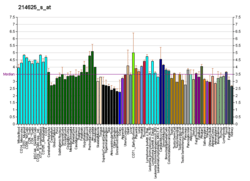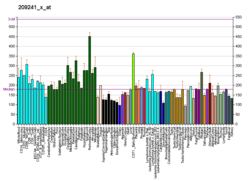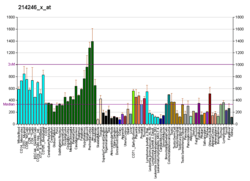MINK1
Misshapen-like kinase 1 is an enzyme that in humans is encoded by the MINK1 gene.[5][6][7]
Function
Misshapen-like kinase 1 is a serine/threonine kinase belonging to the germinal center kinase (GCK) family. The protein is structurally similar to the kinases that are related to NIK and may belong to a distinct subfamily of NIK-related kinases within the GCK family. Studies of the mouse homolog indicate an up-regulation of expression in the course of postnatal mouse cerebral development and activation of the cJun N-terminal kinase (JNK) and the p38 pathways. Alternative splicing occurs at this locus and four transcript variants encoding distinct isoforms have been identified.[7]
Interactions
MINK1 has been shown to interact with NCK1.[8]
gollark: That should make more lake.
gollark: That should make vines.
gollark: But I could have a MORE grown tree.
gollark: Trees GROW in earth, apiobee?
gollark: These make perfect sense. Your game is just wrong.
References
- GRCh38: Ensembl release 89: ENSG00000141503 - Ensembl, May 2017
- GRCm38: Ensembl release 89: ENSMUSG00000020827 - Ensembl, May 2017
- "Human PubMed Reference:". National Center for Biotechnology Information, U.S. National Library of Medicine.
- "Mouse PubMed Reference:". National Center for Biotechnology Information, U.S. National Library of Medicine.
- Dan I, Watanabe NM, Kobayashi T, Yamashita-Suzuki K, Fukagaya Y, Kajikawa E, Kimura WK, Nakashima TM, Matsumoto K, Ninomiya-Tsuji J, Kusumi A (Mar 2000). "Molecular cloning of MINK, a novel member of mammalian GCK family kinases, which is up-regulated during postnatal mouse cerebral development". FEBS Letters. 469 (1): 19–23. doi:10.1016/S0014-5793(00)01247-3. PMID 10708748.
- Dan I, Watanabe NM, Kajikawa E, Ishida T, Pandey A, Kusumi A (Jul 2002). "Overlapping of MINK and CHRNE gene loci in the course of mammalian evolution". Nucleic Acids Research. 30 (13): 2906–10. doi:10.1093/nar/gkf407. PMC 117062. PMID 12087176.
- "Entrez Gene: MINK1 misshapen-like kinase 1 (zebrafish)".
- Hu Y, Leo C, Yu S, Huang BC, Wang H, Shen M, Luo Y, Daniel-Issakani S, Payan DG, Xu X (Dec 2004). "Identification and functional characterization of a novel human misshapen/Nck interacting kinase-related kinase, hMINK beta". The Journal of Biological Chemistry. 279 (52): 54387–97. doi:10.1074/jbc.M404497200. PMID 15469942.
Further reading
- Bonaldo MF, Lennon G, Soares MB (Sep 1996). "Normalization and subtraction: two approaches to facilitate gene discovery". Genome Research. 6 (9): 791–806. doi:10.1101/gr.6.9.791. PMID 8889548.
- Wistow G, Bernstein SL, Wyatt MK, Fariss RN, Behal A, Touchman JW, Bouffard G, Smith D, Peterson K (Jun 2002). "Expressed sequence tag analysis of human RPE/choroid for the NEIBank Project: over 6000 non-redundant transcripts, novel genes and splice variants". Molecular Vision. 8: 205–20. PMID 12107410.
- Gevaert K, Goethals M, Martens L, Van Damme J, Staes A, Thomas GR, Vandekerckhove J (May 2003). "Exploring proteomes and analyzing protein processing by mass spectrometric identification of sorted N-terminal peptides". Nature Biotechnology. 21 (5): 566–9. doi:10.1038/nbt810. PMID 12665801.
- Campdelacreu J, Ezquerra M, Muñoz E, Oliva R, Tolosa E (Apr 2003). "Mutational study of the nuclear factor kappa B inducing kinase gene in patients with progressive supranuclear palsy". Neuroscience Letters. 340 (2): 158–60. doi:10.1016/S0304-3940(03)00105-8. PMID 12668260.
- Beausoleil SA, Jedrychowski M, Schwartz D, Elias JE, Villén J, Li J, Cohn MA, Cantley LC, Gygi SP (Aug 2004). "Large-scale characterization of HeLa cell nuclear phosphoproteins". Proceedings of the National Academy of Sciences of the United States of America. 101 (33): 12130–5. doi:10.1073/pnas.0404720101. PMC 514446. PMID 15302935.
- Hu Y, Leo C, Yu S, Huang BC, Wang H, Shen M, Luo Y, Daniel-Issakani S, Payan DG, Xu X (Dec 2004). "Identification and functional characterization of a novel human misshapen/Nck interacting kinase-related kinase, hMINK beta". The Journal of Biological Chemistry. 279 (52): 54387–97. doi:10.1074/jbc.M404497200. PMID 15469942.
- Olsen JV, Blagoev B, Gnad F, Macek B, Kumar C, Mortensen P, Mann M (Nov 2006). "Global, in vivo, and site-specific phosphorylation dynamics in signaling networks". Cell. 127 (3): 635–48. doi:10.1016/j.cell.2006.09.026. PMID 17081983.
This article is issued from Wikipedia. The text is licensed under Creative Commons - Attribution - Sharealike. Additional terms may apply for the media files.






